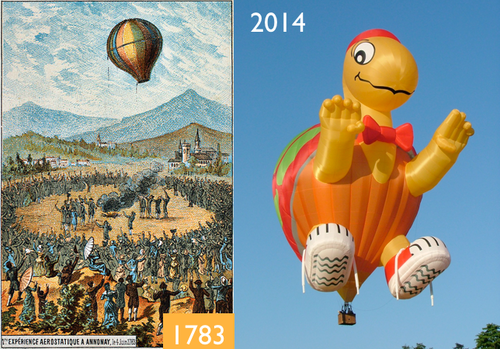The Hotter Way To Fly
 Though many historians credit the Wright Brothers with being the first humans to achieve flight, manned ballooning has a proud tradition dating back to the 18th century.
Though many historians credit the Wright Brothers with being the first humans to achieve flight, manned ballooning has a proud tradition dating back to the 18th century.
Which of these laws best explains why hot air balloons can fly?
In general one of the worst life decisions I have ever made was to not become a hot air balloon pilot.
This section requires Javascript.
You are seeing this because something didn't load right. We suggest you, (a) try
refreshing the page, (b) enabling javascript if it is disabled on your browser and,
finally, (c)
loading the
non-javascript version of this page
. We're sorry about the hassle.
17 solutions
Correction, the volume of a fixed mass of gas under constant presure, is directly proportional to the absolute temprature.
what is charle's law
Log in to reply
Volume is directly proportional to Temperature, when Pressure and number of moles of the gas are constant.
agreed
provided that the pressure is fixed
For a particular mass of gas at a given pressure (treated constant) if the temperature is increased then the volume also increases in the same proportion which further results in a decrease in density (as mass is constant and volume is increasing) and due to density difference buoyancy force comes into action resulting in uplift.
:P
i on't know
i agree with khaled mohamed.. it flies cos pressure increase and this increases the force on the ballon which makes it go upwards(force greater than gravity).. and this is an isochoric process.
thank you
what is the difference between charles law and acsimet force?
Charles' Law states that gases expand by the same factor as temperature increasing. In a hot air balloon the air trapped in the canopy of the balloon is heated with a fire directly underneath the opening of the balloon; the individual particles of air gain kinetic energy and expand, pushing against the sides of the balloon. Thus the balloon rises because there is an overall force upwards.
The volume of a given mass of an ideal gas is directly proportional to its temperature on the absolute temperature scale (in Kelvin) if pressure and the amount of gas remain constant; that is, the volume of the gas increases or decreases by the same factor as its temperature..[1] this directly proportional relationship can be written as: V/T=k
where: V is the volume of the gas T is the temperature of the gas (measured in Kelvin). k is a constant.
- ^ Fullick, P. (1994), Physics, Heinemann, pp. 141–42, ISBN 0-435-57078-1.
Charles law...................................
nice explanation
as a charle's law volume proposnal to temp. so.....density .....is decrase to increase temp.......thats why
According to CHARLES LAW volume is directly proportional to temperature. So, when its temperature is increased, it lifts up because its volume remains constant [hot air rises ] .
Charles law is the best answer for this question .This is because it states that gas expands on heating .
The volume of a given mass of an ideal gas is directly proportional to its temperature on the absolute temperature scale in Kelvin if pressure and the amount of gas remain constant; that is, the volume of the gas increases or decreases by the same factor as its temperature.
charles law as gases expand on heating
an experimental gas law which describes how gases tend to expand when heated.
when we heat up the air,it becomes lighter than the sourrounding air and so due to the buyoncy it rises up
Charles' law (also known as the law of volumes) is an experimental gas law which describes how gases tend to expand when heated. A modern statement of Charles' law is:
The volume of a given mass of an ideal gas is directly proportional to its temperature on the absolute temperature scale (in Kelvin) if pressure and the amount of gas remain constant; that is, the volume of the gas increases or decreases by the same factor as its temperature.[1]
This law explains how a gas expands as the temperature increases; conversely, a decrease in temperature will lead to a decrease in volume.
Charles' law states that volume is directly proportional to absolute temperature
thus as the volume of the same mass of gas increases its density decreases
thus a hot air balloon floats
As the flame is put on , TEMPERATURE inside the balloon increases ( temperature of the gas filled ) which results in the increase in VOLUME of gas (which makes the balloon swell to its size). Since hot air is lighter than cool air , the balloon rises up. Clearly.. it is CHARLES LAW which best explains this stuff!!
Charles' law is an experimental gas law which describes how gases tend to expand when heated. This expansion results in the gas becoming lighter (no. of molecules per liter decreases.) As a result it tends to rise up best explaining why hot air balloons can fly.
as we know according to charles law,volume of a given mass of a gas is increases or decreases by 1/273 of its volume at 0 C ..........it was also the baloon case...we increase the temperature that increases volume of gas...
As we know Charle's Law states that hotter gases expand more and also lighter in weight when compared to their cooler states. So as the hotter gases lighter in weight than its surrounding it tries to go up and lifts a limited amount of weight by staying inside a balloon.
Charles law..because as we heatthe gas , it expands ( if the pressure is kept constant). Since its mass is not changing , the density of gas reduces. As density is lower then atmospheric gas density it can fly.
charles law states that gases expand on heating and hot air balloon follows the same principle to fly